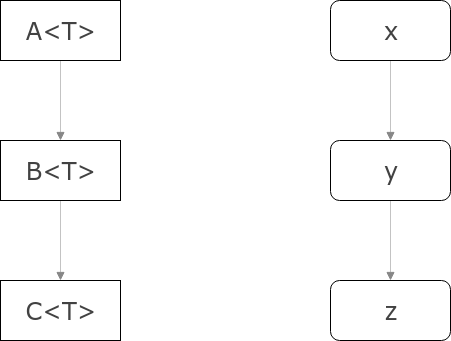Variance in programming languages
Covariance, invariance, and contravariance are concepts many students have difficulties to grasp. However, the idea behind them is pretty simple. This post will attempt to illustrate that in a shortest and simplest way possible.
Take an imaginary object-oriented language with generic types. Java or C# will do. We are going to draw diagrams, where rectangles represent types and arrows represent a relation "is parent of".
A \(\rightarrow\) B means "A is a parent of B", or, in other words, "A
is a supertype of B".
Let's create two hierarchies:
- one consists of three classes, each with a type parameter:
A,BandC; the other contains no parameterized types:
x,y,z.
Now we will draw a 3x3 matrix with all possible substitutions of x, y and z as type parameters of A<T>, B<T> and C<T>, like this:

You already see the arrows like A<x> \(\rightarrow\) B<x>; these are not
going anywhere, they are valid for any value of type argument.
What is of interest to us is: for a parameterized type such as A, how will
A<x> and A<y> be related?
There can be three cases:
- Invariance
- whatever relation exists between
xandy,A<x>andA<y>have no relation whatsoever. - Covariance
- if
x\(\rightarrow\)y, thenA<x>\(\rightarrow\)A<y>. - Contravariance
- if
x\(\leftarrow\)y, thenA<x>\(\rightarrow\)A<y>.

It's all on the picture: for invariance, A<x> and A<y> are not connected for
x \(\neq\) y; for covariance, we draw more arrows according to the hierarchy
of type arguments themselves; for contravariance, we invert these arrows.
Language prerequisites
In order for variance to even exist we need the language to have the following features:
- It has to be typed
It should sometimes allow an entity of type A to be implicitly interpreted as an entity of type B.
The most common cases are:
Subtyping in class hierarchies.
Basically, everything that has an "Object Oriented Programming" label on it: C++, C#, Java etc.
Implicit type conversions (coercions).
For example, in C/C++/Java, there are implicit conversions from numeric types into their wider versions, like
shorttolong, orfloattodouble.
We also need parameterized types.
It does not mean a presence of generics though, as functions alone are enough to introduce covariance and contravariance.
In other words, we need to be able to represent types as an oriented graph.
Common facts
Here I want to mention a couple of facts it is useful to be aware of.
Function variance
Functions are contravariant on arguments and covariant on return type. Why so?
- A function that returns a
Catcan be used to fill a variable of typeAnimal. Hence we got the "natural" way:Animalis more generic thanCat, function returningAnimalis more generic than function returningCat. - If you need a function that can work on
Cat(its argument), it is safe to use a function that can work onAnimalinstead, or any supertype ofCat. Hence, the function with a more generic argument type is of a more specific type itself.
Variance and mutability
As a rule of thumb, immutable collections can be covariant, mutable collections should be invariant.
Imagine, that a mutable List is covariant. Then take a List<String>. You can
reinterpret it as a List<Object>, because Object \(\rightarrow\) String.
That list can store anything, so it is a valid operation to add an integer to
it. From the type perspective, its method set (int idx, T value) will become
set(int idx, Object value), so it is valid to give it an integer as a value.
If we do it, we are screwed because we just have added an integer to a list
that assumes it is holding strings, the objects of an incompatible type,
effectively hacking the type system.
The next time when we try to use some function like printString on all
elements of the said list, we are up for some surprises, ranging (depending on
the language semantics) from runtime errors, to undefined behavior.
In Scala, if you try to define a covariant List, you will get warned on the
definition of its set method, that accepts an argument of type T
(corresponding to the list contents). As an argument of set, T should be
contravariant (as in any function), but as a type parameter of List, it will
be marked as covariant (because we made it so in List definition). Hence the
warning: "Covariant argument in contravariant position".
Immutable collections do not have such problem. If we try to replicate that
example, we will just get a new List of objects, for which it is perfectly
fine to store everything you might want it to.